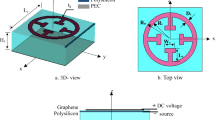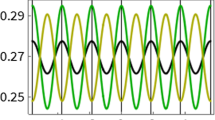Abstract
The phenomenon of Rabi oscillations far from resonance is described in bilayer and few-layer graphene. These oscillations in the population and polarization at the Dirac point in n-layer graphene are seen in the nth harmonic term in the external driving frequency. The underlying reason behind these oscillations is attributable to the pseudospin degree of freedom possessed by all these systems. Conventional Rabi oscillations, which occur only near resonance, are seen in multiple harmonics in multilayer graphene. However, the experimentally measurable current density exhibits anomalous behaviour only in the first harmonic in all the graphene systems. A fully numerical solution of the optical Bloch equations is in complete agreement with the analytical results, thereby justifying the approximation schemes used in the latter. The same phenomena are also described in twisted bilayer graphene with and without an electric potential difference between the layers. It is found that the anomalous Rabi frequency is strongly dependent on twist angle for weak applied fields – a feature absent in single-layer graphene, whereas the conventional Rabi frequency is relatively independent of the twist angle.








Similar content being viewed by others
References
K S Novoselov, A K Geim, S V Morozov, D Jiang, Y Zhang, S V Dubonos, I V Grigorieva and A A Firsov, Science 306, 666 (2004)
P R Wallace, Phys. Rev. 71, 622 (1947)
A K Giem and K S Novoselov, Nat. Mater. 6, 183 (2007)
E McCann and V I Fal’ko, Phys. Rev. Lett. 96, 086805 (2006)
M Mucha-Kruczynski, E McCann and V I Fal’ko, Semicond. Sci. Technol. 25, 033001 (2006)
E McCann, D S L Aberger and V I Fal’ko, Eup. Phys. J.: Special Topic 148, 91 (2006)
J M B Lopes dos Santos, N M R Peres and A H Castro Neto, Phys. Rev. Lett. 99, 256802 (2007)
G Li, A Luican, J M B Lopes dos Santos, A H Castro Neto, A Reina, J Kong and E Andrei, Nat. Phys. 6, 109 (2009)
A Luican, G Li, A Reina, J Kong, R Nair, K S Novoselov, A K Geim and E Andrei, Phys. Rev. Lett. 106, 126802 (2011)
W Yan, M Lui, R F Dou, L Meng, L Feng, Z D Chu, Y F Zhang, Z F Lui, J C Nie and L He, Phys. Rev. Lett. 109, 126801 (2012)
Enamullah, V Kumar and G S Setlur, Physica B 407, 4600 (2012)
I I Rabi, Phys. Rev. 51, 652 (1937)
R W Boyd, Nonlinear optics (Singapore, Elsevier, 2009)
L Allen and J H Eberly, Optical resonances and two-level atoms (Wiley and Sons, New York, 1975)
H Haug and S W Koch, Quantum theory of optical and electronic properties of semiconductors, 4th edn (World Scientific, Singapore, 2004)
K L Ishikawa, Phys. Rev. B 82, 201402 (2010)
H K Avetissian, A K Avetissian, G F Mkrtchian and Kh V Sedrakian, Phys. Rev. B 85, 115443 (2012)
X Yao and A Belyanin, Phys. Rev. Lett. 108, 255503 (2012)
B Dora, K Ziegler, P Thalmeier and M Nakamura, Phys. Rev. Lett. 102, 036803 (2009)
A R Wright, X G Xu, J C Cao and C Zhang, Appl. Phys. Lett. 95, 072101 (2009)
P N Romanets and F T Vasko, Phys. Rev. B 81, 241411 (2010)
E G Mishchenko, Phys. Rev. Lett. 103, 246802 (2009)
Y Zhou and M W Wu, Phys. Rev. B 83, 245436 (2011)
S A Mikhailov, Physica E 40, 2626 (2008)
S A Mikhailov, Physica E 44, 924 (2012)
Y S Ang, S Sultan and C Zhang, Appl. Phys. Lett. 97, 243110 (2010)
D S L Abergel and V I Fal’ko, Phys. Rev. B 75, 155430 (2007)
A R Wright, J C Cao and C Zhang, Phys. Rev. Lett. 103, 207401 (2009)
B Partoens and F M Peeters, Phys. Rev. B 75, 193402 (2007)
H Min and A MacDonald, Phys. Rev. B 77, 155416 (2008)
T Ohta, A Bostwick, J L McChesney, T Seyller, K Horn and E Rotenberg, Phys. Rev. Lett. 98, 206802 (2007)
K F Mak, J Shan and T F Heinz, Phys. Rev. Lett. 104, 176404 (2010)
C L Lu, C P Chang, Y C Haung, R B Chen and M L Lin, Phys. Rev. B 73, 144427 (2006)
I T Lin, J M Liu, K Y Shi, P S Tseng, K H Wu, C W Luo and L J Li, Phys. Rev. B 86, 235446 (2012)
R de Gail, M O Goerbig, F Guinea, G Montambaux and A H Castro Neto, Phys. Rev. B 84, 045436 (2011)
Y H Wen, Z D Chu and L Hi, Phys. Rev. Lett. 111, 066803 (2013)
Enamullah, Vipin Kumar, Upendra Kumar and Girish S Setlur, Pramana – J. Phys. 82, 1085 (2014)
M Koshino and E McCann, arXiv:1104.0794 (2011)
F Zhang, B Sahu, H Min and A H MacDonald, Phys. Rev. B 82, 035409 (2010)
Author information
Authors and Affiliations
Corresponding author
Appendices
Appendix A
In this section, we present the solution of Bloch equations at resonance for multilayer graphene. The general Bloch equations for n-layer graphene are
The above equations exhibit what may be termed as ‘harmonic resonances’. Their description is as follows. First, we diagonalize a time-independent matrix formed by the Bloch equations, when the external field is absent, and that may be diagonalized by making the substitution,
Now, the full Bloch equations may be written in a matrix form as follows:
where
are combinatorial factors. Now, we transform to the new variables.
In this case, we retain only one value of m in the above equation, denoted by m=ν, anticipating that the resonance will occur for that particular value of ν for which ν ω=2λ|k|n. The other values of ν are far from resonance for the value of |k| obeying this equation. In such a situation we may write
where
Rotating wave approximation involves using \( \tilde {\pi }({\vec {k}},t) = \mathrm {e}^{2 i t \lambda |k|^{n} }\quad \tilde {\pi }^{\prime }({\vec {k}},t) \) and using ν ω−2λ|k|n≡Δ≪ν ω so that
Appendix B
In this section, we describe the analytical expressions used for generating the central result of our work, viz. figure 2. All the three parts of figure 2 are obtained through a numerical solution of the nonlinear equation for the eigenfrequency (see our earlier work [11]). In our earlier work, we showed that the plots are equally well represented by a simple smooth interpolation of subplots applicable in different regimes, where analytical expressions are possible (the last four equations on p. 4606 of that work). Here too, we adopt the same strategy to obtain:
(a) For single-layer graphene:
The conventional Rabi frequency is related to the fields in single-layer graphene through, \(\omega _{\mathrm {R}} = v_{\mathrm {F}}|\frac {e}{c} {\vec {\sigma }}_{\text {BA}}\cdot {\vec {A}}(0)|\).
(b) For BLG:
(c) for trilayer graphene:
where Δ=(ν ω−2α|k|3). ν=1,2,3 for first, second and third harmonic resonances, respectively. These formulae clearly show the harmonic resonances associated with conventional Rabi oscillations.
Rights and permissions
About this article
Cite this article
KUMAR, V., ENAMULLAH, KUMAR, U. et al. Coherent nonlinear electromagnetic response in twisted bilayer and few-layer graphene. Pramana - J Phys 83, 597–617 (2014). https://doi.org/10.1007/s12043-014-0808-4
Received:
Revised:
Accepted:
Published:
Issue Date:
DOI: https://doi.org/10.1007/s12043-014-0808-4




